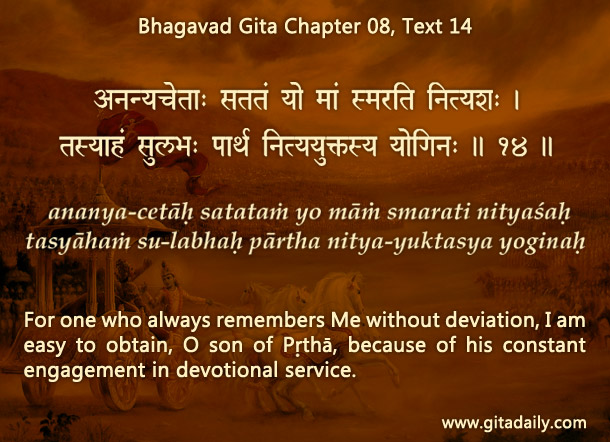Yogis, specifically dhyana-yogis, start meditation by focusing on some point, such as the tip of the nose or the space between the eyebrows.
As such yogis advance, they turn their focus inwards and meditate on the immanent manifestation of Krishna present in their heart. As long as they think of Krishna as simply a point for concentration, their progress depends on their own spiritual determination. They don’t ask him for help, in fact, they don’t even think of him as a source of help, for to them he is just a focus-point. And he reciprocates by not intervening in their spiritual journey.
Of course, very few yogis think of Krishna as a mere focus point. But taking their extreme example illustrates graphically the limitation of the path of yoga, even when its focus is Krishna. Even those yogis who see Krishna as a source of mercy often entertain deep down the notion that he is not the ultimate reality, but is a transitional tool for attaining an impersonal ultimate reality. Such a notion undercuts the sincerity of their devotion and proportionately undercuts their reception of his mercy.
Some yogis by associating with devotees understand that the Absolute Truth is eternally and essentially personal, as the Gita (07.07) declares. Acknowledging the ultimate sentience of the highest transcendence brings authenticity and depth to their devotional supplication and opens their heart fully to receive his grace. That mercy eases and accelerates their spiritual journey.
The Bhagavad-gita while overviewing yoga in its sixth chapter acknowledges the difficulty of that path (06.33–34). The Gita contrasts the difficulty of yoga with the felicity of bhakti by declaring (08.14) that those who remember Krishna constantly attain him easily, thereby unequivocally endorsing bhakti as the best path to spiritual perfection.

Explanation of article:
https://www.youtube.com/watch?v=eICep84Zz0M

Hare krishna dear prji.
Pamho. Agtsp. Does this article by any chance remotely suggest that it is better for those Bhaktas who wish to remember krishna’s form (not for yoga but as a form of nava vidha bhakti) should do so not in their heart but only externally or elsewhere. Remembering krishna as situated in the heart brings an element of closeness and togetherness.
Ys
subash
No, it doesn’t. Because the word ‘just’ in ‘Krishna is not just a point for meditation’ conveys that he is an object for meditation (in our heart among other places) – and he is more too.
ys
ccdas
Hare Krishna Dear Prabhuji,
PAMHO. AGTSP. Thanks for wonderfully bringing out the contrast and connection between the verses in chapter 6 and chapter 8. The highlighting of the word “Sulabha” in this verse is very encouraging indeed for us KG seekers.
Ys
subash
Although Arjuna says that it is difficult to control the mind 6.34), in the latter slokas, Lord Sri-Krishna explains how one can attain such arduous dhyana-yoga through diligent practice.
Also, in Srimad-Bhagavatam (SB 11.14.31-46), Lord Sri-Krishna explains the same process to Udhava.
Undoubtedly, Devotees are the supreme yogis of all (6.47), but to attain such a state of unflinching devotion/concentration, one should have a control mind. Therefore, dhyana-yoga looks like a precursor to Bhakti-yoga; since through dhyana-yoga one can transcend the gross-&-subtle senses so as to be determinately/resolutely situated in the process of Bhakti forever.
Answered here:
http://www.thespiritualscientist.com/2014/09/as-yogis-become-bhaktas-at-their-topmost-stage-does-that-mean-we-should-practice-yoga-before-bhakti/
ys
ccdas